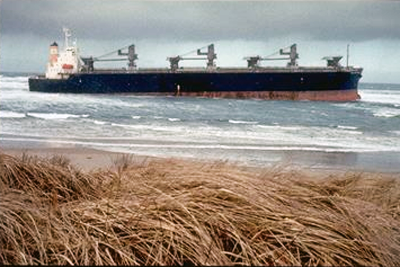Introduction:
Designerly ways of knowing
 The New Carissa just after grounding ashore. NOAA image.
The New Carissa just after grounding ashore. NOAA image.
 The creation of this info graphic led to new understandings of how the grounding occurred, and a called into question the captains account.
The creation of this info graphic led to new understandings of how the grounding occurred, and a called into question the captains account.
In this instance, the designers's vector graphic software package and design abilities were transformed from their typical purpose of communicating understood ideas into a tool for creating new knowledge. To pervert a phrase, "designerly ways of knowing" the world lead to new understandings of it.
"Designerly ways of knowing" is a phrase Nigel Cross has used since the early eighties to describe what designers uniquely know. For Cross, that includes only "'the artificial world'--the human-made world of artifacts." In which designers' "... knowledge, skills, and values lie in the techniques of the artificial… [and] how to contribute to the creation and maintenance of that world." (N. Cross 2001, pg 54) It does not include using design to understand the world or culture--what he considers the realms of science and humanities (N. Cross 2006, pg 2). For Cross "Designerly ways of knowing" does not include the concept of research through design or design as research. As he states on the Wikipedia talk page for the 'Design Research' entry, "I have always struggled with the concept of research 'through' design." (N. Cross, 'Talk:Design Research'.) I reject Cross's narrow scope for design research.
It is in this sense--that a designer can know the world in a unique way--that I constructed a thesis project toward the development of a design research practice.